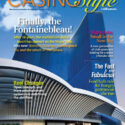
In the 21st century, the pace of change has quickened almost beyond recognition, or our ability to keep up. So, where and how does change really originate?
In his 2015 book The Evolution of Everything: How New Ideas Emerge, author Matt Ridley refuted the belief that change comes from the top down, as dictated by Big Government, Big Business, Big Tech, Big Brother, and various other “bigs.”
According to Ridley, revolutionary change actually comes from the bottom up, as everyday people demonstrate with their time, money and attention what they’re willing to invest in. His thesis: the view from the top is really informed by the wants and needs of the masses at the bottom—meaning you and me and millions of other consumers of goods and services.
It’s a recurring theme in this edition of Casino Style, starting with the cover story, on page 16. Roger Gros writes about two new resorts that opened in Las Vegas last year—the long-awaited Fontainebleau on the Strip, and Station Casinos’ Durango in the valley—as well as two other properties that have undergone major remodels, the Rio and the Sahara. All these changes were motivated by consumer demand and the determination of operators to serve the customer niche, as they define it.
On page 22, Frank Legato explains how slot floors—still the bread and butter of casino revenue—first changed in response to Covid-19 safety protocols, and ended up creating a new and better player experience.
On page 26, we look at a growing trend away from vast nightclubs and million-dollar DJs to more intimate, personal and social spaces—a phenomenon driven by people’s desire for entertainment that is democratic, affordable and inclusive.
Turn to page 30 for a look at casino F&B as embodied by food halls. Jess Marquez asks industry experts how these marketplaces improved on both casino buffets and food courts, and revitalized the fast-casual dining scene for patrons on the move.
For an example of the inevitability of change, see page 34 for our bittersweet farewell to the Mirage. When it opened in November 1989, Steve Wynn’s Mirage was the most expensive resort in the world, at $630 million. News accounts called it a “Fantasy Island” come to life, a “South Seas dream” with 3,000 hotel rooms, cascading waterfalls, a tiger habitat, and the property’s signature feature: a volcano that spewed lava every quarter-hour. The Mirage kicked off the mega-resort era and set a new standard for Strip entertainment and hospitality. But all things must pass, and the Mirage will soon close, to be rebranded as a Hard Rock property.
This issue of Casino Style is all about change, and the bottom-up demand that informs it. It also asks: What’s your change management strategy?











